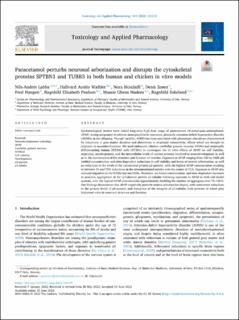| dc.contributor.author | Labba, Nils-Anders Johannes | |
| dc.contributor.author | Wæhler, Hallvard Austin | |
| dc.contributor.author | Houdaifi, Nora | |
| dc.contributor.author | Zosen, Denis | |
| dc.contributor.author | Haugen, Fred | |
| dc.contributor.author | Paulsen, Ragnhild Elisabeth Heimtun | |
| dc.contributor.author | Hadera, Mussie Ghezu | |
| dc.contributor.author | Eskeland, Ragnhild | |
| dc.date.accessioned | 2023-02-15T08:43:53Z | |
| dc.date.available | 2023-02-15T08:43:53Z | |
| dc.date.created | 2022-06-27T12:01:32Z | |
| dc.date.issued | 2022 | |
| dc.identifier.issn | 0041-008X | |
| dc.identifier.uri | https://hdl.handle.net/11250/3050928 | |
| dc.description.abstract | Epidemiological studies have linked long-term/high-dose usage of paracetamol (N-acetyl-para-aminophenol, APAP) during pregnancy to adverse neuropsychiatric outcomes, primarily attention-deficit hyperactive disorder (ADHD), in the offspring. Though variable, ADHD has been associated with phenotypic alterations characterized by reductions in grey matter densities and aberrations in structural connectivity, effects which are thought to originate in neurodevelopment. We used embryonic chicken cerebellar granule neurons (CGNs) and neuronally differentiating human NTERA2 cells (NT2Ns) to investigate the in vitro effects of APAP on cell viability, migration, neuritogenesis, and the intracellular levels of various proteins involved in neurodevelopment as well as in the maintenance of the structure and function of neurites. Exposure to APAP ranging from 100 to 1600 μM yielded concentration- and time-dependent reductions in cell viability and levels of neurite arborization, as well as reductions in the levels of the cytoskeletal protein β2-spectrin, with the highest APAP concentration resulting in between 50 and 75% reductions in the aforementioned metrics over the course of 72 h. Exposure to APAP also reduced migration in the NT2Ns but not CGNs. Moreover, we found concentration- and time-dependent increases in punctate aggregation of the cytoskeletal protein β3-tubulin following exposure to APAP in both cell model systems, with the highest APAP concentration approximately doubling the number of aggregates over 72–120 h. Our findings demonstrate that APAP negatively perturbs neurite arborization degree, with concurrent reductions in the protein levels of β2-spectrin and disruption of the integrity of β3-tubulin, both proteins of which play important roles in neuronal structure and function. | |
| dc.language.iso | eng | |
| dc.title | Paracetamol perturbs neuronal arborization and disrupts the cytoskeletal proteins SPTBN1 and TUBB3 in both human and chicken in vitro models | |
| dc.title.alternative | Paracetamol perturbs neuronal arborization and disrupts the cytoskeletal proteins SPTBN1 and TUBB3 in both human and chicken in vitro models | |
| dc.type | Peer reviewed | |
| dc.type | Journal article | |
| dc.description.version | publishedVersion | |
| dc.source.volume | 449 | |
| dc.source.journal | Toxicology and Applied Pharmacology | |
| dc.identifier.doi | 10.1016/j.taap.2022.116130 | |
| dc.identifier.cristin | 2035373 | |
| dc.relation.project | Sigma2: NN9632K | |
| cristin.ispublished | true | |
| cristin.fulltext | original | |
| cristin.qualitycode | 2 | |
